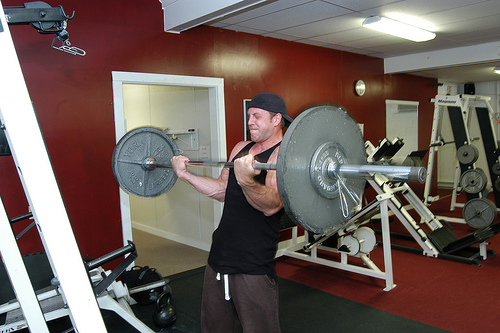The barbell curl is a key exercise to building bigger and better biceps. It is to the biceps what the squat is to the legs. Here is a description of how to perform the barbell curl and why it is beneficial to your biceps.
Technique of the barbell curl
Grasp a barbell with an underhand grip, that is, with the palms facing up, about shoulder width apart. Stand straight, feet slightly apart for balance, back arched slightly, shoulders pulled back gently and chest thrust forward. Start the exercise with your arms hanging down and by taking a deep breath before.
Curl the bar up whilst holding your breath. Keep you upper arms static while moving only your forearms and hands. The hardest part, the sticking part as it is called, is when your arms form a 90 degrees angle at the elbow and your forearms are parallel to the floor. Once you pass this sticking point, exhale forcefully and bring the bar up to your chest. You will find that it is impossible to stop the upper arms from moving at all, especially at the top of the exercise. This is normal and part of the natural movement of this free-weight exercise.
Once at the top of the exercise, don’t rest but lower the bar down under control. At the bottom, don’t rest either and keep a slight bend in your elbows to keep the biceps under tension.
why it’s a biceps mass-builder
As with any exercise, it is not possible to entirely isolate the biceps from other muscles, so with the barbell curl, the shoulder muscles, in particular, the anterior deltoid, are partially recruited. This is why it is important to keep the upper arms fixed to minimise work done by the shoulders in raising the bar and also why the barbell curl is sometimes regarded as a compound exercise for the biceps.
In addition, the position to perform this exercise is a natural and a fundamental movement of the arms and the leverage that you get allows to lift heavy. Couple that to the fact that you are using both arms and that the barbell curl is a free weight exercise and you start to understand why it is so popular and so effective at working the biceps thoroughly.
The barbell curl may also be easily modified in order to keep the muscles guessing, a fundamental aspect of bodybuilding. So for example, you can use an EZ-bar instead of a barbell, you can even use dumbbells instead of a bar or move on to a machine that replicates the movement. You can vary your grip width and thus target different angles of the biceps head. By holding the bar with the palms facing down, you work the brachialis, that muscle between the biceps and triceps on the exterior side of the arms. As you can see, every time you vary this exercise, you change its focus on the biceps.
Cheating
The barbell curl is not a perfect exercise and its main disadvantage is considerable indeed. Anyone who has done this exercise to their limit would have noticed the sticking point which severely limits the maximum amount of weight that can be lifted. As a result, lifters have a natural tendency to cheat, or use a sloppy form during the exercise in order to get past it. Cheating involves bending the knee, moving the upper arms but more commonly, bending backwards. So keep an eye on these and try not to do them.
Another post will discuss cheating at the barbell curl in much more detail. For now, stick to proper form and enjoy working your biceps with this mass-builder.
Image credit: locknloadtraining.

